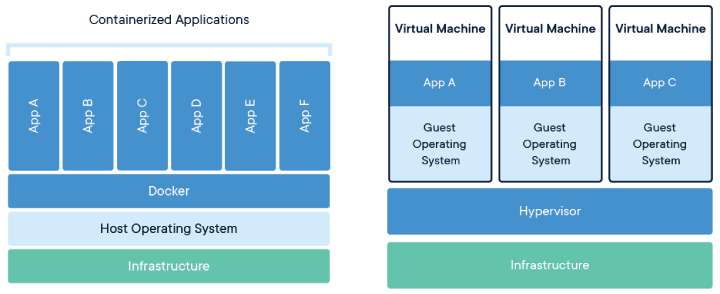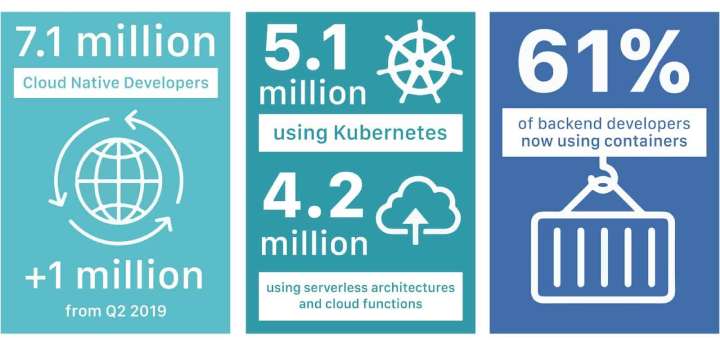ALEXANDRIA, Va. — In 2011, Marc Andreessen declared that “software is eating the world.” Today, that software is cloud native and it’s hungry for space—specifically satellite communications.
 More enterprises are shifting workloads to the cloud and using containerized or cloud native functions to run applications and business segments. (Source: Pixabay)
More enterprises are shifting workloads to the cloud and using containerized or cloud native functions to run applications and business segments. (Source: Pixabay)
For those who have been watching the telecommunication industry’s cloud transition, the trend has been moving from geographically fixed, proprietary hardware environments to distributed, virtual networks and industry standards. This has implications for satellite network operators seeking to do business with telcos, particularly in the 5G era and beyond.
“What transpired in the telecom industry is a precursor to what should be happening in the satellite industry,” said Keith Basil, General Manager of Edge at SUSE, who has helped terrestrial and satellite providers deploy cloud native solutions.
He urged satcom providers not to ignore the evolution to virtual and cloud native architectures that is taking place among terrestrial connectivity providers. “At the end of the day, it’s really a competitive advantage,” Basil noted. “It’s also about being relevant to the end customers in terms of the satellite communication capabilities they need to offer.”
The Telco Cloud Journey
Like today’s satcom systems, the previous generation of telecommunications services was dominated by purpose-built, proprietary machines.
Software-defined networking (SDN) proved to be an effective architecture for managing the exponential growth of connected devices and supporting services otherwise requiring manual configuration. It was also a way to reduce dependence on costly, proprietary hardware used to deliver and expand core services.
SDN is about disaggregating the hardware and software layer of the network. Virtualization, or using software to replicate physical hardware functions and performance, is both at the heart of SDN and one of the infrastructure pillars of 5G.
“5G changed everything because 5G is cloud native-based,” explained Luc-Yves Pagal Vinette, a market and technology strategist and product marketing director at Amdocs Networks E2E Solutions. “MNOs [mobile network operators] didn’t have a choice. If they wanted to tap into the opportunity of 5G they needed to evolve quickly, they needed to evolve by yesterday to cloud native.”
The transition from 4G to 5G accelerated cloud adoption, including software- and infrastructure-as-a-service (IaaS and SaaS). This was driven as much by the need for technical capabilities, like scale and flexibility, as it was by business practicalities. In adopting cloud, operators could shift costs from CAPEX to OPEX. This allowed them to continue amortizing existing hardware investments while building out new virtual network infrastructure without sapping cash flow.
Telcos started their journey to cloud native with network function virtualization (NFV). This paradigm was designed for the cloud and involved virtual machines (VMs) and virtual network functions (VNFs) managed by a hypervisor (VMware, KVM, LXC, et al.). VMs have advantages like scalability, supporting multi-tenant provisioning and isolation. A virtual machine running on an isolated portion of a host computer carries its own operating system and virtual hardware, enabling it to run multiple applications with different operating systems simultaneously on the same infrastructure. However, this is a heavy lift that requires lots of physical compute resources and a highly complex, cumbersome software stack.
 Containers and virtual machines have similar resource isolation and allocation benefits but function differently. Containers are more portable and virtualize the OS instead of the hardware. (Source: Docker.com/CC BY-SA 4.0, Wikimedia Commons)
Containers and virtual machines have similar resource isolation and allocation benefits but function differently. Containers are more portable and virtualize the OS instead of the hardware. (Source: Docker.com/CC BY-SA 4.0, Wikimedia Commons)
Over time, more complex VNFs were broken down into disaggregated microservices and cloud native functions (CNFs) running inside containers. Just as virtualization is at the heart of software-defined networking, containerization is at the heart of cloud native. Compared to VMs, containers are much more lightweight and agile. Instead of carrying an entire computing environment, they contain only the tools, library and dependencies needed to run an application in a cloud native environment. This design enables users to run an application almost anywhere without needing to rebuild it for a new environment.
Today, telcos are moving more in the direction of CNFs and containerized solutions for network management functions. But VMs continue to be useful in situations demanding higher levels of observability, control, fault tolerance and availability. Since containers can run on VMs (as well as bare metal), both can and do coexist in the same enterprise and the operator can derive the benefits of each.
Cloud Native Shortcuts for Satcom?
Satellite connectivity is on the cusp of becoming mainstream. The 2023 Mobile World Congress (MWC) in Barcelona featured new announcements of direct-to-device applications and plenty of buzz about the deeper integration of satellite and terrestrial communications networks under future 5G releases. But the market is not there yet.
There is growing recognition that bringing space and terrestrial capabilities together, as envisioned by 5G, will require seamless communication at the network level between enterprises, operating systems and cloud environments. Mobile carriers understood this in evolving away from proprietary hardware solutions toward virtualized network functions, cloud native and the increasingly common use of open-source tools. Yet the ability to tap into that ecosystem is still almost nonexistent among most satellite service providers.
While it’s no secret that terrestrial telcos and mobile network operators (MNOs) are ahead of satcom providers in evolving core services into virtual and cloud environments, satellite may be able to catch up.
Pagal Vinette noted that satellite network operators have an opportunity to learn from telcos’ cloud journey and accelerate the timeline to becoming cloud native.
“If you want to evolve to cloud native, you can start with the easiest part, which is the network,” he said. As an initial step, the network-related capabilities at the teleport can be disaggregated into virtual functions.
“The disaggregated network could be cloud native from the get-go and anchored to the service orchestration platform,” he continued. This will enable satcom providers to create a new generation of services and an inroad to collaborate with telcos at the network level. “This is a shortcut they can take.”
A Brief Note on Kubernetes
Cloud native architectures essentially rely on a handful of underlying concepts, including agility, flexibility and portability. The latter is a critical for allowing developers to consistently deploy the same application in any cloud environment, whether its public, private or edge, any VM and even bare metal.
 The Cloud Native Computing Foundation (CNCF) estimated there are now 7.1 million cloud native developers worldwide, a majority of whom use Kubernetes. (Source: CNCF/“State of the Cloud Native Development Report” by SlashdDot)
The Cloud Native Computing Foundation (CNCF) estimated there are now 7.1 million cloud native developers worldwide, a majority of whom use Kubernetes. (Source: CNCF/“State of the Cloud Native Development Report” by SlashdDot)
The cloud native architecture itself is comprised of layers starting with hardware layer, which runs the containers through an intermediate virtualization layer on top of the operating system, like Docker. The containers are then orchestrated by a Container Orchestration Engine (COE), such as Kubernetes, Docker Swarm or others. These COEs eliminate manual processes, making it easier for enterprises to deploy and scale containerized applications. Kubernetes, which originated inside of Google and is now maintained by the Cloud Native Computing Foundation (CNCF), is one of the largest open-source initiatives in the world and has become the de facto standard for cloud native orchestration.
On top of the Kubernetes or COE layer are applications, network functions, monitoring, observability and at the top is the Operational Service System (OSS), which contributes to end-to-end service orchestration and management, delegating each lower domain to allocate resources and organize itself to formalize the desired service.
Kubernetes serves as the go-between to organize containers, determine when to scale vertically or horizontally and when to terminate them based on the higher-order needs of end-to-end service orchestration.
Toward an Era of Collaboration
All the traditional benefits of cloud native that apply to telcos and IT enterprises apply in the context of a satellite network: cost effective deployment and provisioning of services, automation, flexibility, increased speed to market, serverless platforms and security. The ability to leverage open-source tools to create portable applications for any cloud environment is also a critical advantage.
“If I wanted to deploy a cloud application in 2008, I would have to make a conscious choice between [vendors],” explained Basil. “That choice is a heavy one, because if I have a team of 12 developers, we’re all going to have to skilled up on an Amazon or Google or another API and ecosystem. Kubernetes frees everybody from that, and we have freedom of choice on the platform on the backend.”
This element of the cloud native movement represents a further step away from vendor-locked solutions toward standards and open-source tools. Fundamentally, that transition is helping to establish a common language and common methodologies that could enable more collaboration among service providers and end users, such as satellite operators, MNOs, hyperscalers and others.
“This is really what will make the future exciting for all of us in this industry,” said Pagal Vinette. “In the next 5-10 years, the first question people will ask a vendor will be, ‘Can you collaborate with [other vendors]?’” That ability to collaborate at the network level is also expected to grow in importance as satellite services play a larger role in the global 5G ecosystem.
Explore More:
Podcast: NFV, SDN and Enabling Dynamic Satellite Ground Networks
Podcast: Satellites Integrated with Telcos, 5G and a Converging World
How Edge Computing Is Changing Space from Terminal to Satellite
Ready for Mainstream? Challenges of Satellite 5G
